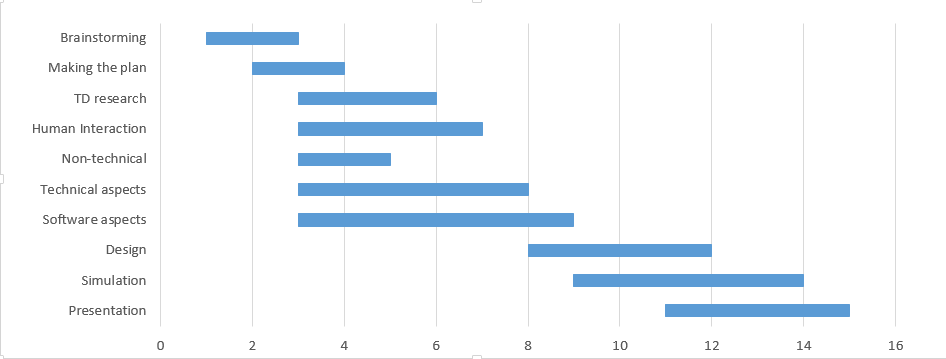PRE2018 3 Group11:Organization
<link rel=http://cstwiki.wtb.tue.nl/index.php?title=PRE2018_3_Group11&action=edit"stylesheet" type="text/css" href="theme.css"> <link href='https://fonts.googleapis.com/css?family=Roboto' rel='stylesheet'>
Go back to the homepage.
Group Composition
Group 11 consists of five diverse people. Firstly, there is Nimo Beeren (1019824). Nimo is a double bachelor student, doing both Software Science as well as Web Science. As expected, his strong points include programming. Secondly we have [Name omitted], a student who knows his way around Psychology and Technology. [Name omitted] is a critical thinker, and provides a psychological point of view to the team. To strengthen the team of programming-savvy people there is Işılsu Keleş (1035673). Işılsu brings not online programming knowledge to the team as Software Science student, but provides her great writing skills as well. Since no robot-building team is complete without at least one mechanical engineer, this group contains one as well. Pim Van Hees (0966509) is the go-to person when it comes to building anything. Finally, there is Daniel Barenholz (0998941), a third Software Scientist. He is decent at organisation and management, and provides this to the team. All in all, group 11 is a small but experienced multidisciplinary team.
Deliverables
We have decided to deliver two verifiable things.
- Design. Firstly, we will be making a design for the drone. This design is complete if it can be built using only the information as presented in the wiki, except for assumed background knowledge of construction or other respective fields like programming.
- Simulation (model). In addition to a concrete design, we will be creating a (visual) simulation. More information w.r.t. this deliverable will be added when we have researched the best way for simulating the drone in a clear fashion.
Milestones
In order to achieve the above-mentioned deliverables, we have defined several milestones. These can also be found in the approach section for completeness sake, albeit in different structure and format.
- Completion of research on Topographical Disorientation (TD).
- Completion of research on Human interaction.
- Completion of research on Non-technical aspects of drones.
- Completion of research on Technical aspects of drones.
- Completion of research on Software aspects of drones.
- Completion of design.
- Completion of working, sensible simulation.
Task division
Who will work towards what milestone/deliverable. This might still change during the project.
- For the research on DTD Işılsu works on how it affects the daily life people that suffer from it. [Name omitted] researches the user-base of the disorder.
- Research on human interaction is done by [Name omitted] and Daniel.
- Research on non-technical issues is done by Pim.
- Research on software aspects is lead by Nimo, but other people will help.
- Research on technical aspects is lead by Pim.
- Design is done by [Name omitted] and Pim
- Simulation is done by Daniël, Işılsu and Nimo.
- Everyone will work on the presentation
Planning
The planning of the whole project should include deadlines for each of the deliverables and milestones that were established. We can change this as time goes on.
- The research for DTD is started in week 2 and is mainly finished on monday of week 3 (18-2) so it can be discussed in the meeting. After the meeting additions and changes can be made until next wednesday (20-2) so it can be uploaded to the wiki for the tutor meeting on thursday (21-2).
- The research on human interaction will also start in week 2. First ideas for the sub-points are discussed in the meeting on monday of week 3 (18-2). Then before the monday in week 4 (25-2) the research on this subject is completed and during the meeting the main options for human interaction are chosen.
- The research on non-technical aspects (only legal issues) is completed before the meeting on monday week 3 (18-2).
- The research on software aspects for the drone takes some more time. It will take from week 2 until the meeting of monday week 5 (11-3). Every meeting in between progress is reported and further tasks are discussed.
- The research for the technical aspects is completed by thursday week 4 (28-2). The research on battery life and charging are done before the meeting on monday, week 3 (18-2), then the research on weather limitations and how the drone flies is done before the next monday (25-2). During the meeting that monday everything is discussed so it can be finalized and put on the wiki before the deadline.
- As soon as the technical aspects are done the design is started. From thursday week 4 (28-2) possible options are researched for the components. These are then chosen before thursday week 5 (14-3) and discussed during the meeting next monday. Then until thursday week 6 (21-3) the design is finalized and possible technical drawings are made.
- From monday week 5 (11-3) until thursday week 7 (28-3) work is done on the simulation.
- Work on the presentation should be started monday week 6 (18-3). On thursday week 7 (28-3) it should be finished so that the remainder of the time can be spent practising the presentation.
Here a the plan is given in a graphical manner. On the x-axis of the graph are the numbers of the meetings starting at meeting 1 (monday 4-2, week 1) and ending at 15 or 16 (1-4 and 4-4, week 8). The bars show at which meetings every item starts and at which meeting it should be completed.
